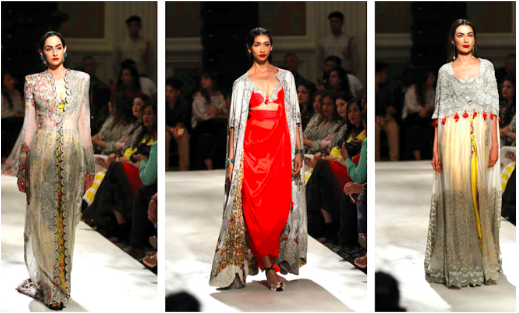Eastern Wear Pakistan: Necessary Closet Parts for each Style Lover
Unveiling the Rich Heritage of Eastern Style
Exploring the detailed tapestry of Eastern fashion unveils a globe where tradition satisfies innovation, and workmanship intertwines with social symbolism. From the luxurious silks of ancient empires to the intricate needlework of nomadic tribes, each garment narrates that transcends time and boundaries, echoing the abundant heritage and imaginative tradition of the East. As we peel off back the layers of history and custom, a fascinating trip waits for, deciphering the keys behind the captivating appeal and long-lasting influence of Eastern style on the international stage.
Origin of Eastern Fashion

In Mesopotamia, for instance, the Sumerians and Babylonians produced garments making use of linen, natural leather, and wool, adorned with detailed patterns and fashion jewelry. Old Egyptians are renowned for their advanced weaving skills and the usage of lightweight, breathable materials like linen. Chinese fashion stressed the significance of shade symbolism and complex needlework techniques, while Indian garments included dynamic colors, glamorous textiles like silk and cotton, and elaborate drapery designs such as the saree.
These old civilizations not only affected each various other but likewise led the way for the culturally rich and varied tapestry that is modern Eastern style. Via centuries of evolution, Eastern fashion continues to grow, mixing tradition with modern influences to produce one-of-a-kind and timeless designs.
Cultural Impacts and Practices
Attracting from centuries-old custom-mades and beliefs, social impacts and customs play an essential function fit the essence of Eastern style (eastern wear pakistan). The abundant tapestry of cultures across Eastern regions such as Asia, the Center East, and Africa has actually greatly influenced the clothes styles, colors, fabrics, and designs that are widespread in Eastern style today
In nations like India, Japan, and China, conventional garments like cheongsams, robes, and sarees continue to hold significant social value and are commonly decorated with elaborate embroidery or symbolic patterns that mirror deep-rooted beliefs and values. In Middle Eastern countries, the moving abayas and kaftans worn by males and women not only offer as moderate attire however also mirror the region's cultural heritage and Islamic practices.
Additionally, the usage of particular shades like red completely luck in Chinese society or complex geometric patterns motivated by Islamic design better exhibit how social influences materialize in Eastern style - eastern wear pakistan. By honoring and preserving these social influences and customs, Eastern style remains to progress while staying true to its abundant heritage
Evolution of Eastern Attire
Gradually, Eastern garments have undertaken significant improvements, reflecting a blend of custom and modernity in their layout and style. Standard Eastern garments such as the saree, bathrobe, salwar, and hanbok kameez have developed to include modern elements while protecting their cultural essence.
One remarkable evolution is making use of ingenious materials and strategies in Eastern garment construction. Conventional handwoven textiles like silk and cotton have actually been complemented with contemporary products such as polyester and blends, supplying increased sturdiness and convenience of treatment. In addition, innovations in printing technologies have made it possible for intricate patterns and designs to be integrated into Eastern garments with precision and detail.
Furthermore, modifications in silhouette and tailoring have updated Eastern attire, making them extra versatile and ideal for varied occasions. Standard outfit codes have actually relaxed, enabling for testing with decorations, styles, and shades. This evolution has not only made Eastern garments extra attractive and easily accessible to a worldwide target market however has also guaranteed their proceeded significance in contemporary style landscapes.
Meaning in Eastern Outfit
Checking out the ingrained cultural relevance woven into Eastern attire introduces a rich tapestry of meaning and practice. Eastern garments are commonly imbued with icons that show the user's social status, religious ideas, and social identity.
Additionally, particular garments hold symbolic significances. Its style, textile, and even the way it is put on all lug deep social value.

Influence of Eastern Style Today

The unification of Eastern elements in Western fashion has led to a combination of designs that deal with varied preferences and choices (eastern wear pakistan). Developers often draw motivation from Eastern silhouettes, fabrics, and patterns, creating innovative and special items that mix standard and contemporary aesthetics. This cross-cultural exchange has not only renewed the garment industry yet additionally promoted a deeper appreciation for Eastern heritage and workmanship
Additionally, the increase of social networks and digital platforms has even more amplified the impact of Eastern style, enabling brand names and developers to reach a larger audience and display their cultural heritage to the world. Via partnerships, fashion programs, and check this on-line campaigns, Eastern fashion remains to develop and prosper in today's interconnected and dynamic international landscape.
Verdict
In final thought, the rich heritage of Eastern style is a testament to the social influences, intricate workmanship, and extensive symbolism installed in each garment. From old civilizations to contemporary interpretations, Eastern style remains to astound with its one-of-a-kind blend of practice and technology. The effect of Eastern style today serves as a tip of the timeless style and creative expression that have actually made it a over at this website worldwide sensation celebrated for its abundant cultural heritage.
Discovering the complex tapestry of Eastern style reveals a globe where tradition satisfies innovation, and craftsmanship links with cultural meaning.The enduring meaning and cultural relevance embedded in Eastern clothes proceed to form and influence the modern influence of Eastern fashion today. Eastern fashion has actually gone beyond borders, ending up being an international phenomenon embraced by designers, celebrities, and style fanatics worldwide.In conclusion, the rich heritage of Eastern style is a testimony to the social influences, elaborate craftsmanship, and extensive symbolism embedded in each garment. The impact of Eastern fashion today serves as a tip of the classic elegance and creative expression that have made it a worldwide sensation commemorated for its abundant cultural heritage.